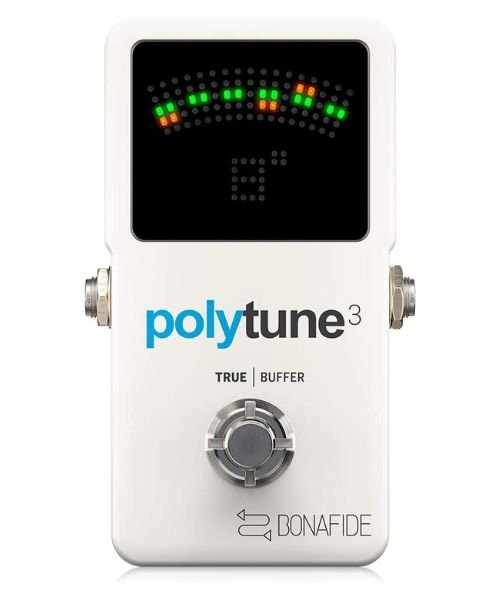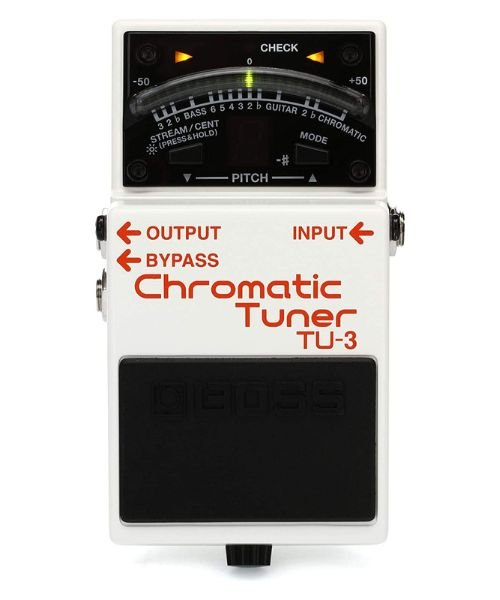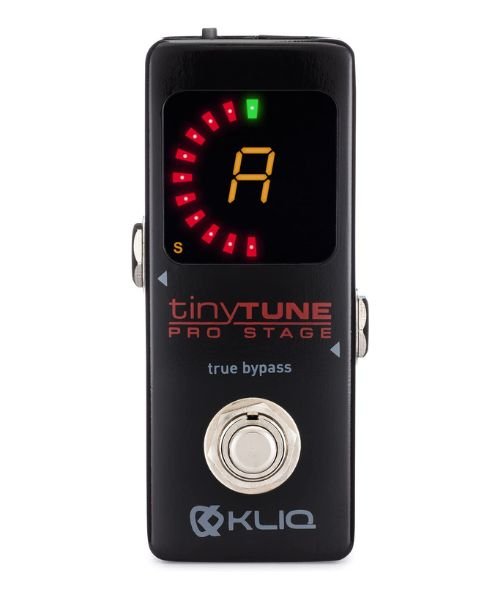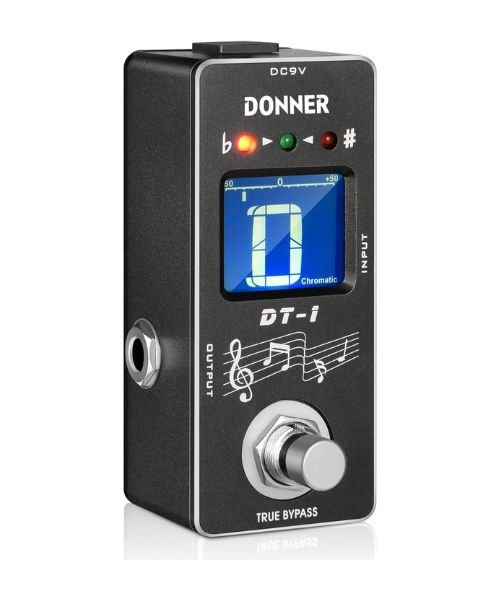A quality tuner pedal helps us with accuracy and efficiency instead of having to fiddle with our tuning pegs and ear tuning. Whether laying down the foundation for a tight rhythm section, stepping into the spotlight for a mind-blowing solo, or being in tune in general, a tuner pedal can do your job. Amidst the flux of tuner pedals finding the proper one can be overwhelming; that’s why I’ve done the legwork, tested some of the market-buzzing pedals, and narrowed it down to the 5 best tuner pedal for bass that’ll let you groove in tune. So, without further ado, let’s get started.
See Also: 7 Best Sustain Pedal For Guitar
List of the Best Tuner Pedal For Bass
1. TC Electronic POLYTUNE 3 (Best overall)
Key Features
- Style: Compact
- Bypass Type: Switchable
- Item Weight: 9.5 ounces
- Battery: 9V
- Product Dimensions: 4.76 x 1.77 x 2.87 inches
The POLYTUNE 3 is a remarkable polyphonic tuning pedal for bass, renowned for its impressive accuracy of +/-0.5 cents. However, its capabilities extend beyond tuning. The pedal is a versatile tool that lets you seamlessly switch between various tuning modes such as chromatic, polyphonic, and strobe. With the strobe mode, you can achieve an almost perfect pitch with a precision of +/-0.02 cents! On top of it, the switchable Bonafide buffer feature ensures that the signal remains clear and noise-free, even when multiple effects pedals are in use. Despite its compact size, the tuner boasts an easily legible LED display, visible in virtually any lighting condition. Overall, the POLYTUNE 3’s accuracy, versatility, and ease of use place it firmly on the top of my list.
Pros
- Incredibly accurate
- 3 different tuning modes
- Switchable Bonafide buffer mode
- Bright LED
- Compact size
- Lightweight
Cons
- Not so comfortable for big feet
2. Boss TU-3 Chromatic Tuner Pedal (Best display)
Key Features
- Style: Compact
- Bypass Type: Buffered
- Item Weight: 0.019 ounces
- Battery: 9V
- Product Dimensions: 6 x 3.85 x 2.65 inches
The TU-3 is an improved version of the highly regarded TU-2, which holds the title of the best-selling tuner pedal worldwide. With the tuning accuracy of +/- 1, this pedal can detect even the slightest tuning deviations, which means you’ll always be in tune. Moreover, it features various tuning modes for both guitars and bass, and the chromatic mode allows you to tune to any note. One of the standout features of the TU-3 is the flat tuning mode. It means you can tune down a half-step (six semitones below standard pitch) without manually retuning the guitar. Another impressive feature of this tuner is the 21-segment LED display that indicates the proximity to achieving optimal tuning. You can even adjust the display to high brightness mode for enhanced visibility in brightly lit or outdoor environments.
Pros
- Easy to use
- Buffered bypass maintains clarity
- Large & clear display
- Flat tuning mode
- Chromatic and Guitar/Bass mode
- Sturdy construction
Cons
- A bit pricey
3. KLIQ TinyTune Pro Stage Tuner Pedal (Best compact size)
Key Features
- Style: Compact
- Bypass Type: True
- Item Weight: 5.1 ounces
- Battery: 9V
- Product Dimensions: 3.86 x 1.22 x 1.5 inches
After POLUTUNE 3, KLIQ TinyTune Pro is another pedal on my list with an incredible accuracy of +/- 0.5 cents. This little pedal packs a punch with its compact design, chromatic tuning capabilities, and versatile features. One of the awesome things about this pedal is its fast response time. In mere seconds, it accurately detects even the slightest changes in pitch and adjusts accordingly. It also features a large, easy-to-read display, perfect for on-stage use. You’ll find that the TinyTune Pro is easy to use. It responds quickly and accurately to every note you play. Moreover, this tuner pedal comes with a true bypass and flat tuning feature, like the BOSS TU-3. One drawback I found is that the pedal requires a power supply to function.
Pros
- Bright and easy-to-read LED display
- True bypass ensures an unaltered guitar tone
- High level of accuracy
- Compact size
- Sturdy construction
- 1-year warranty
Cons
- Requires a power supply
4. Donner Tuner Pedal (Best Easy-to-use)
Key Features
- Style: Mini
- Bypass Type: True
- Item Weight: 4.2 ounces
- Battery: 9V
- Product Dimensions: 2.36 x 2.36 x 4.72 inches
If you’re looking for an accurate pedal tuner and, at the same time, easy to use, this Donner Tuner Pedal tuner is worth checking out! This little beauty has got you covered for acoustic and electric guitars and can handle various genres and playing styles. The coolest feature of this tuner is its precise strobe mode, which boasts an impressive accuracy of +/- 1 cent. With its true bypass design, your tone stays pure and uncolored even when the pedal is turned off. It also features a bright LED display with a mini-LCD screen. The one-button design lets you step on it to activate the tuning mode easily. The LED display is so clear in any dark environment you play.
Pros
- Highly accurate
- Bright LED
- Easy-to-use
- Wide tuning range
- True bypass mode
Cons
- Requires a power supply
5. Peterson StroboStomp HD Guitar Tuner (403884) (Best Accuracy)
Key Features
- Bypass Type: Switchable
- Item Weight: 13.9 ounces
- Battery: 9V
- Product Dimensions: 5 x 2.6 x 2.1 inches
Peterson strobe tuners are reputed for their exceptional quality. This HD tuner offers the best accuracy of +/- 0.1 cents on my list and comes with both true and buffered bypass modes. It also has 135 unique tunings specially adjusted to suit various instrument types and altered tunings. You’ll like its ability to save presets, which makes tuning changes during live performances a breeze. Moreover, it boasts a high-definition LCD screen with a variable-colored LED backlight. The strobe image and note name are displayed in a monochromatic format that’s super easy on the eyes, even when playing outside in direct sunlight.
Pros
- Highly accurate
- True bypass & buffer mode
- Bright LED with ambient adjustment
- Tuning presets
Cons
- Comparatively expensive
How To Choose The Best Tuner Pedal For Bass?
Type of Tuner:
There are a variety of options to consider depending on where you’ll be using the tuner – whether at gigs, in the studio, or at home. Here is a brief overview of the different types of tuners available:
Chromatic Tuners – These are among the most popular types of tuners, and they come in the form of a clip-on, microphone, or pedal. Using a chromatic tuner, you can easily tune each note within the chromatic scale, which includes all 12 notes spanning octaves. Although they may not be the best option for beginners due to their complexity, they are a great choice if you play multiple instruments or want a tuner that can be used with any instrument.
Polyphonic Tuners – These tuners are the newest addition to the market and were innovated by TC Electronic and adopted by Korg. They provide a holistic view of your guitar’s current tuning, allowing you to identify how tuning one string will affect the others.
Strobe Tuners – These are the most accurate tuners available, although they may come with a higher price tag. These tuners use a microprocessor to measure the waveform and translate it into a user-friendly frequency reading. Additionally, they create a reference frequency and display the difference. If you want extremely precise tuning, strobe tuners are the way to go.
Microphone Tuners – This type of tuner relies on a built-in microphone to detect the notes’ frequency. Although they are not the most precise, they are helpful for simple tuning tasks. Generally, these tuners display the out-of-tune strings by the standard EADGBE guitar tuning, but they do not detect semi-tones like Ab. They are a good choice if you want to avoid the hassle of cables.
What to consider when choosing a tuner for a specific setting?
When choosing a tuner for a specific setting, such as at a gig or in the studio, there are a few factors to consider.
- Consider the tuner’s accuracy and how precise you need your tuning. If you require the most accurate tuning, strobe tuners are the way to go.
- Think about the ease of use and how quickly you need to tune your instrument. Microphone tuners are helpful for simple tuning tasks.
- Take into account whether you need a tuner that can be used with multiple or just one specific instrument. Chromatic tuners are a great choice if you play multiple instruments or want a tuner that can be used with any instrument.
Tuning Accuracy:
A common unit for measuring tuning accuracy is cents. Choose your tuner pedal with a tuning accuracy of at least +/- 1 cent to ensure your bass is properly tuned and produces excellent sound quality.
What exactly does a tuning accuracy of +/- 1 cent mean for a tuner?
Cent refers to the pitch variation from the desired note frequency. A tuner with a tuning accuracy of at least +/- 1 cent means that the tuner can detect even small deviations in pitch and display them accurately. For example, if a bass or guitar string is tuned to the note A440, a variance of 1 cent would mean the frequency is slightly higher or lower by 1/100th of a semitone, which is barely perceptible to the human ear.
Display:
Another crucial factor to consider is visibility. Whether playing in a dimly lit club or under the bright stage lights, you’ll want a tuner with a clear, easy-to-read display in your tuner pedal.
Which type of display is better, LCD or LED?
Both LCD and LED displays have their advantages and disadvantages. LCD displays typically have better visibility in bright environments and wider viewing angles, while LED displays tend to have better contrast and can be easier to read in darker environments. Ultimately, it depends on the specific environment where you will use the tuner pedal.
True Bypass or Buffered Mode:
Using a true bypass or buffered mode for pedals depends on how you’ve set up your pedalboard. If you have a limited number of effects pedals, true bypass is preferred as it maintains the tone quality. However, a buffered mode is better if you have many pedals. A buffered tuner’s active circuitry can help sustain the guitar’s tone and simplify tuning, particularly with a more intricate signal chain.
Why is a buffered tuner better for a complex pedalboard?
The signal chain can become quite long in a pedalboard with many effects pedals. Each pedal can cause some signal loss, leading to tone degradation and a weaker overall sound. A buffered tuner’s active circuitry helps to counteract this by restoring some of the lost signals and maintaining the original tone quality. Additionally, a buffered tuner can simplify tuning by ensuring the guitar’s signal stays strong and stable throughout the chain. It’s especially helpful when working with more complex effects setups.
Final Words
There’s nothing more satisfying than nailing that perfect pitch and hearing your bass resonate with the rest of the band. A quality tuner pedal offers far more than just accurate tuning; it can play a key role in helping you properly set up your instrument. So, choosing the right tuner pedal is crucial for your bass-playing experience. Whether you’re looking for reliability, versatility, accuracy, or affordability, one of the five pedals on this list of the best tuner pedal for bass is sure to meet your needs.





